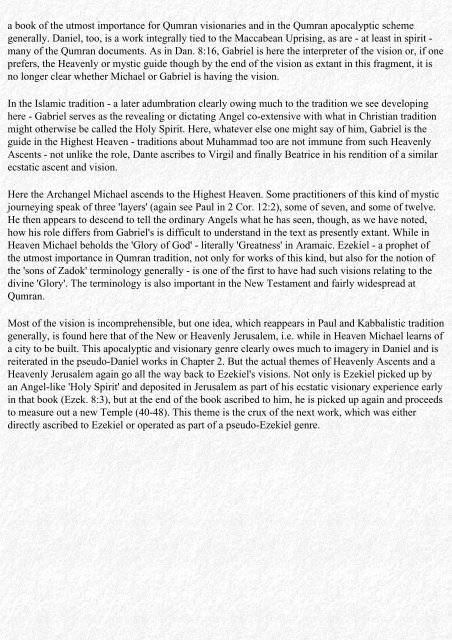Dead Sea Scrolls Uncovered - The Preterist Archive
Dead Sea Scrolls Uncovered - The Preterist Archive
Dead Sea Scrolls Uncovered - The Preterist Archive
Create successful ePaper yourself
Turn your PDF publications into a flip-book with our unique Google optimized e-Paper software.
a book of the utmost importance for Qumran visionaries and in the Qumran apocalyptic scheme<br />
generally. Daniel, too, is a work integrally tied to the Maccabean Uprising, as are - at least in spirit -<br />
many of the Qumran documents. As in Dan. 8:16, Gabriel is here the interpreter of the vision or, if one<br />
prefers, the Heavenly or mystic guide though by the end of the vision as extant in this fragment, it is<br />
no longer clear whether Michael or Gabriel is having the vision.<br />
In the Islamic tradition - a later adumbration clearly owing much to the tradition we see developing<br />
here - Gabriel serves as the revealing or dictating Angel co-extensive with what in Christian tradition<br />
might otherwise be called the Holy Spirit. Here, whatever else one might say of him, Gabriel is the<br />
guide in the Highest Heaven - traditions about Muhammad too are not immune from such Heavenly<br />
Ascents - not unlike the role, Dante ascribes to Virgil and finally Beatrice in his rendition of a similar<br />
ecstatic ascent and vision.<br />
Here the Archangel Michael ascends to the Highest Heaven. Some practitioners of this kind of mystic<br />
journeying speak of three 'layers' (again see Paul in 2 Cor. 12:2), some of seven, and some of twelve.<br />
He then appears to descend to tell the ordinary Angels what he has seen, though, as we have noted,<br />
how his role differs from Gabriel's is difficult to understand in the text as presently extant. While in<br />
Heaven Michael beholds the 'Glory of God' - literally 'Greatness' in Aramaic. Ezekiel - a prophet of<br />
the utmost importance in Qumran tradition, not only for works of this kind, but also for the notion of<br />
the 'sons of Zadok' terminology generally - is one of the first to have had such visions relating to the<br />
divine 'Glory'. <strong>The</strong> terminology is also important in the New Testament and fairly widespread at<br />
Qumran.<br />
Most of the vision is incomprehensible, but one idea, which reappears in Paul and Kabbalistic tradition<br />
generally, is found here that of the New or Heavenly Jerusalem, i.e. while in Heaven Michael learns of<br />
a city to be built. This apocalyptic and visionary genre clearly owes much to imagery in Daniel and is<br />
reiterated in the pseudo-Daniel works in Chapter 2. But the actual themes of Heavenly Ascents and a<br />
Heavenly Jerusalem again go all the way back to Ezekiel's visions. Not only is Ezekiel picked up by<br />
an Angel-like 'Holy Spirit' and deposited in Jerusalem as part of his ecstatic visionary experience early<br />
in that book (Ezek. 8:3), but at the end of the book ascribed to him, he is picked up again and proceeds<br />
to measure out a new Temple (40-48). This theme is the crux of the next work, which was either<br />
directly ascribed to Ezekiel or operated as part of a pseudo-Ezekiel genre.

















